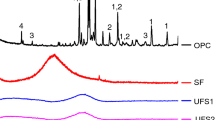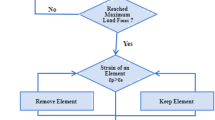Abstract
This paper further investigates the hypothesis and recent preliminary findings that hydrotalcite is responsible for the remarkable improvement of chloride binding in concretes containing ground granulated blast furnace slag (GGBFS). In this paper, the chloride binding capacity of hydrotalcite has been examined in a wide range of GGBFS and GGBFS-OPC (ordinary Portland cement) blends. X-ray diffraction (XRD) was conducted to identify hydrotalcite in GGBFS pastes and to distinguish it from Friedel’s salt. Using Rietica software for quantifying crystalline minerals, this paper presents quantified XRD analysis of the relative proportion of hydrotalcite formed in GGBFS and binary blend pastes. XRD revealed that hydrotalcite was formed in all pastes containing GGBFS. The results clearly demonstrated that hydrotalcite made up a significant proportion of the crystalline phase in GGBFS pastes. The results further showed that the ability of hydrotalcite to bind chlorides was not significantly impaired by the competitive adsorption of carbonates.








Similar content being viewed by others
References
Song H-W, Saraswathy V (2006) Studies on the corrosion resistance of reinforced steel in concrete with ground granulated blast-furnace slag—an overview. J Hazard Mater B138:226–233
Bertolini L, Elsener B, Pedeferri P, Polder R (2004) Corrosion of steel in concrete. Wiley-VCH Verlag GmbH & Co KGaA, Weinheim
Leng F, Feng N, Lu X (2000) An experimental study on the properties of resistance to diffusion of chloride ions of fly ash and blast furnace slag concrete. Cem Concr Res 30:989–992
Dhir RK, El-Mohr MAK, Dyer TD (1996) Chloride binding in GGBS concrete. Cem Concr Res 26(12):1767–1773
Luo R, Cai Y, Wang C, Huang X (2003) Study of chloride binding and diffusion in GGBS concrete. Cem Concr Res 33:1–7
Song S, Jennings HM (1999) Pore solution chemistry of alkali-activated ground granulated blast-furnace slag. Cem Concr Res 29:159–170
Haque MN, Kayyali OA, Gopalan MK (1992) Fly ash reduces harmful chloride ions in concrete. ACI Mater J 89(3):238–241
Taylor HFW (1997) Cement chemistry. Thomas Telford Publishing, Thomas Telford Services Ltd, London
Hewlett PC (2004) Lea’s chemistry of cement and concrete. Elsevier Science & Technology Books, San Diego
Douglas GB, Wendling LA, Pleysier R (2009) Hydrotalcite formation for contaminant removal from mining wastewaters. In: International mine water conference proceedings, Pretoria, pp 407–414
Bejoy N (2001) Hydrotalcite: the clay that cures. Resonance 6:57–61
Takaaki W, Tomoe S, Yasuyuki I (2006) New simple process of making agricultural cultivation solution from seawater. Bull Soc Sea Water Sci Jpn 60(3):201–202
Álvarez D, Collazo A, Hernández M, Nóvoa XR, Pérez C (2010) Corrosion protective properties of hydrotalcites doped hybrid sol-gel coatings on aluminium substrates. Mater Sci Forum 636–637:996–1003
Yang Z, Fischer H, Polder R (2013) Synthesis and characterization of modifiedhydrotalcites and their ion exchange characteristics in chloride-rich simulated concrete pore solution. Cem Concr Compos (in press)
Yang Z, Fischer H, Polder R (2013) Modified hydrotalcites as a new emerging class of smart additive of reinforced concrete for anticorrosion applications: a literature review. Mater Corros 64(9999):1–9
Kayali O, Khan MSH, Ahmed MS (2012) The role of hydrotalcite in chloride binding and corrosion protection in concretes with ground granulated blast furnace slag. Cement Concr Compos 34(8):936–945
Hunter B (1998) Rietica—a visual Rietveld program. Commission on Powder Diffraction Newsletter (20)
Rietveld HM (1969) A profile refinement method for nuclear and magnetic structures. J Appl Crystallogr 2:65–71
Miyata S (1983) Anion-exchange properties of hydrotalcite-like compounds. Clays Clay Miner 31(4):305–311
Mineral Data Publishing (2001–2005)
Misra C, Perrotta AJ (1992) Composition and properties of synthetic hydrotalcite. Clays Clay Miner 40(2):145–150
Palmer SJ, Nguyen T, Frost RL (2009) Hydrotalcites and their role in coordination of anions in Bayer liquors: anion binding in layered double hydroxides. Coord Chem Rev 253(1–2):250–267
Wang S-D, Scrivener KL (1995) Hydration products of alkali activated slag cement. Cem Concr Res 25(3):561–571
Rayment GE, Lyons D (2010) Soil chemical methods. Australasia CSIRO Publishing, Collingwood
Taylor JC, Hinczak I (2004) Rietveld made easy: a practical guide to the understanding of the method and successful phase quantifications. Sietronics Pty Limited, Belconnen
van der Ven L, van Gemert MLM, Batenburg LF, Keern JJ, Gielgens LH, Koster TPM, Fischer HR (2000) On the action of hydrotalcite-like clay materials as stabilizers in polyvinylchloride. Appl Clay Sci 17:25–34
Narayanan S, Krishna K (1999) Structure activity relationship in Pd/hydrotalcite: effect of calcination of hydrotalcite on palladium dispersion and phenol hydrogenation. Catal Today 49:57–63
Mindess S, Young JF, Darwin D (2003) Concrete. Pearson Education Inc, Harlow
Escalante-Garcı´a JI, Fuentes AF, Gorokhovsky A, Fraire-Luna PE, Mendoza-Suarez G (2003) Hydration products and reactivity of blast-furnace slag activated by various alkalis. J Am Soc 86(12):2148–2153
Bernal SA, Nicolas RS, Myers RJ, de Gutiérrez RM, Puertas F, van Deventer JSJ et al (2014) MgO content of slag controls phase evolution and structural changes induced by accelerated carbonation in alkali-activated binders. Cem Concr Res 57:33–43
Haha MB, Lothenbach B, Saout GL, Winnefeld F (2012) Influence of slag chemistry on the hydration of alkali-activated blast-furnace slag—Part II: effect of Al2O3. Cem Concr Res 42:74–83
Haha MB, Lothenbach B, Saout GL, Winnefeld F (2011) Influence of slag chemistry on the hydration of alkali-activated blast-furnace slag—Part I: effect of MgO. Cem Concr Res 41:955–963
Gollop RS, Taylor HFW (1996) Microstructural and microanalytical studies of sulphate attack. V. comparison of different slag blends. Cem Concr Res 26(7):1029–1044
Phoo-ngernkham T, Chindaprasirt P, Sata V, Pangdaeng S, Sinsiri T (2013) Properties of high calcium fly ash geopolymer pastes with Portland cement as an additive. Int J Miner Metall Mater 20(2):214–218
Way SJ, Shayan A (1989) Early hydration of portland cement in water and sodium hydroxide solutions:composition of solutions and nature of solid phases. Cem Concr Res 19:759–769
Ahari KG, Sharp JH, Lee WE (2002) Hydration of refractory oxides in castable bond systems—I: alumina, magnesia, and alumina–magnesia mixtures. J Eur Ceram Soc 22:495–503
Wang JA, Morales A, Bokhimi X, Novaro O (1999) Cationic and anionic vacancies in the crystalline phases of sol-gel magnesia-alumina catalysts. Chem Mater 11(2):308–313
Erickson KL, Bostrom TE, Frost RL (2004) A study of structural memory effects in synthetic hydrotalcites using Environmental SEM. Mater Lett 59:226–229
Jr JVB, Brown PW (2004) PhreeqC modeling of Friedel’s salt equilibria at 23 ± 1 °C. Cem Concr Res 34:1057–1063
Ishida T, Miyahara S, Maruya T (2008) Chloride binding capacity of mortars made with various Portland cements and mineral admixtures. Journal of Advance Concrete Technology 6(2):287–301
Ahmed MS (2007) Effects of systematic increase of pozzolanic materials on the mechanical, durability, and microstructural characteristics of concrete. Canberra, University of New South Wales @ the Australian Defence Force Academy
Chindaprasirt P, Jaturapitakkul C, Sinsiri T (2007) Effect of fly ash fineness on microstructure of blended cement paste. Constr Build Mater 21:1534–1541
Acknowledgments
The authors would like to acknowledge the continuous supports from the University of New South Wales, Canberra throughout this research.
Author information
Authors and Affiliations
Corresponding author
Rights and permissions
About this article
Cite this article
Khan, M.S.H., Kayali, O. & Troitzsch, U. Chloride binding capacity of hydrotalcite and the competition with carbonates in ground granulated blast furnace slag concrete. Mater Struct 49, 4609–4619 (2016). https://doi.org/10.1617/s11527-016-0810-z
Received:
Accepted:
Published:
Issue Date:
DOI: https://doi.org/10.1617/s11527-016-0810-z




